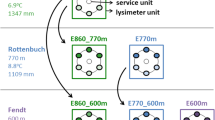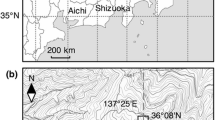Abstract
We investigated concentrations of dissolved organic carbon (DOC) in throughfall and soil solutions at 5, 15 and 40-cm depth in 16 Norway spruce and two Scots pine plots throughout Norway between 1996 and 2006. Average DOC concentrations ranged from 2.3 to 23.1 mg/l and from 1.1 to 53.5 mg/l in throughfall water and soil solutions, respectively. Concentrations of DOC in throughfall and soil waters varied seasonally at most plots with peaks in the growing season. By contrast to recently reported positive long-term trends in DOC concentrations in surface waters between 1986 and 2003, soil water data from 1996 to 2006 showed largely negative trends in DOC concentrations and no significant trends in throughfall. However, regression analysis for individual sites, particularly at 5- and 15-cm soil depths, showed that DOC concentrations in soil water were significantly and negatively related to non-marine sulphate (SO4) and chloride (Cl−). The lack of a long-term increase in DOC in soil water in the period May 1996–December 2006 may be due to the relatively small changes in the deposition of SO4 and Cl− in this period.








Similar content being viewed by others
References
Andersson, S., & Nilsson, S. I. (2001). Influence of pH and temperature on microbial activity, substrate availability of soil-solution bacteria and leaching of dissolved organic carbon in a mor humus. Soil Biology & Biochemistry, 33(9), 1181–1191. doi:10.1016/S0038-0717(01)00022-0.
Andersson, S., Nilsson, S. I., & Sætre, P. (2000). Leaching of dissolved organic carbon (DOC) and dissolved organic nitrogen (DON) in mor humus as affected by temperature and pH. Soil Biology & Biochemistry, 32(1), 1–10. doi:10.1016/S0038-0717(99)00103-0.
Broecker, W. S. (1974). Chemical oceanography. New York: Harcourt Brace Jovanovich.
Christ, M. J., & David, M. B. (1996). Temperature and moisture effects on the production of dissolved organic carbon in a spodosol. Soil Biology & Biochemistry, 28(9), 1191–1199. doi:10.1016/0038-0717(96)00120-4.
Clarke, N., Røsberg, I., & Aamlid, D. (2005). Concentrations of dissolved organic carbon along an altitudinal gradient from Norway spruce forest to the mountain birch/alpine ecotone in Norway. Boreal Environment Research, 10(3), 181–189.
Clarke, N., Wu, Y., & Strand, L. T. (2007). Dissolved organic carbon concentrations in four Norway spruce stands of different ages. Plant and Soil, 299, 275–285. doi:10.1007/s11104-007-9384-4.
Dalva, M., & Moore, T. R. (1991). Sources and sinks of dissolved organic carbon in a forested swamp catchment. Biogeochemistry, 15(1), 1–19. doi:10.1007/BF00002806.
de Wit, H. A., Mulder, J., Hindar, A., & Hole, L. (2007). Long-term increase in dissolved organic carbon in streamwaters in Norway is response to reduced acid deposition. Environmental Science & Technology, 41(22), 7706–7713. doi:10.1021/es070557f.
Easter, G. (1987). SAS/GRAPH ® Guide for personal computers. Cary: SAS Institute.
Evans, C. D., Chapman, P., Clark, J., Monteith, D. T., & Cresser, M. (2006). Alternative explanations for rising dissolved organic carbon export from organic soils. Global Change Biology, 12(11), 2044–2053. doi:10.1111/j.1365-2486.2006.01241.x.
Falkengren-Grerup, U. (1994). Importance of soil solution chemistry to field performance of Galium odoratum and Stellaria nemorum. Journal of Applied Ecology, 31(1), 182–192. doi:10.2307/2404610.
FAO (1988). FAO-UNESCO Soil Map of the World, Revised Legend. Rome: FAO.
Freeman, C., Fenner, N., Ostle, N. J., Kang, H., Dowrick, D. J., Reynolds, B., et al. (2004). Export of dissolved organic carbon from peatlands under elevated carbon dioxide levels. Nature, 430(6996), 195–198. doi:10.1038/nature02707.
Fröberg, M., Berggren, D., Bergkvist, B., Bryant, C., & Mulder, J. (2006). Concentration and fluxes of dissolved organic carbon (DOC) in three Norway spruce stands along a climatic gradient in Sweden. Biogeochemistry, 77(1), 1–23. doi:10.1007/s10533-004-0564-5.
Fröberg, M., Berggren Kleja, D., Bergkvist, B., Tipping, E., & Mulder, J. (2005). Dissolved organic carbon leaching from a coniferous forest floor - a field manipulation experiment. Biogeochemistry, 75(2), 271–287. doi:10.1007/s10533-004-7585-y.
Gobran, G. R., & Nilsson, S. I. (1988). Effects of forest floor leachate on sulfate retention in a spodosl soil. Journal of Environmental Quality, 17(2), 235–239.
Gödde, M., David, M. B., Christ, M. J., Kaupenjohann, M., & Vance, G. F. (1996). Carbon mobilization from the forest floor under red spruce in the northeastern U.S.A. Soil Biology & Biochemistry, 28(9), 1181–1189. doi:10.1016/0038-0717(96)00130-7.
Guggenberger, G., & Zech, W. (1992). Retention of dissolved organic-carbon and sulfate in aggregated acid forest soils. Journal of Environmental Quality, 21(4), 643–653.
Guggenberger, G., Zech, W., & Schulten, H. (1994). Formation and mobilization pathways of dissolved organic matter: evidence from chemical structural studies of organic matter fractions in acid forest floor solutions. Organic Geochemistry, 21(1), 51–66. doi:10.1016/0146-6380(94)90087-6.
Hole, L.R., & Tørseth, K. (2002) Deposition of major inorganic compounds in Norway 1978–1982 and 1997–2001: status and trends. ISBN 82-425-1410-0. NILU.73 pp.
Joyner, S. P. (1985). SAS/STAT TM Guide for personal computers. Cary: SAS Institute.
Kaiser, K., Guggenberger, G., Haumaier, L., & Zech, W. (2001). Seasonal variations in the chemical composition of dissolved organic matter in organic forest floor layer leachates of old-growth Scots pine (Pinus sylvestris L.) and European beech (Fagus sylvatica L.) stands in northeastern Bavaria, Germany. Biogeochemistry, 55(2), 103–143. doi:10.1023/A:1010694032121.
Kendall, M. G. (1975). Rank correlation methods. London: Charles Griffin.
Kopáček, J., Stuchlík, E., & Hardekopf, D. (2006). Chemical composition of the Tatra Mountain lakes: recovery from acidification. Biologia, 61, S21–S33. doi:10.2478/s11756-006-0117-6.
Kvaalen, H., Solberg, S., Clarke, N., Torp, T., & Aamlid, D. (2002). Time series study of concentrations of SO 2−4 and H+ in precipitation and soil waters in Norway. Environmental Pollution, 117(2), 215–224. doi:10.1016/S0269-7491(01)00271-8.
Libiseller, C. (2004). MULTMK/PARTMK a program for the computation of multivariate and partial Mann–Kendall tests.
Ma, J. F. (2000). Role of organic acids in detoxification of aluminum in higher plants. Plant & Cell Physiology, 41(4), 383–390.
Michalzik, B., & Matzner, E. (1999). Dynamics of dissolved organic nitrogen and carbon in a central European Norway spruce ecosystem. European Journal of Soil Science, 50(4), 579–590. doi:10.1046/j.1365-2389.1999.00267.x.
Michalzik, B., Kalbitz, K., Park, J. H., Solinger, S., & Matzner, E. (2001). Fluxes and concentrations of dissolved organic carbon and nitrogen-a synthesis for temperate forests. Biogeochemistry, 52(2), 173–205. doi:10.1023/A:1006441620810.
Monteith, D. T., Stoddard, J. L., Evans, C. D., de Wit, H. A., Forsius, M., Høgasen, T., et al. (2007). Dissolved organic carbon trends resulting from changes in atmospheric deposition chemistry. Nature, 450(7169), 537–540. doi:10.1038/nature06316.
Montgomery, D. C., Peck, E. A., & Vining, G. G. (2001). Introduction to liner regression analysis. New York: Wiley.
Neff, J. C., & Asner, G. P. (2001). Dissolved organic carbon in terrestrial ecosystems: Synthesis and a model. Ecosystems (New York, N.Y.), 4(1), 29–48. doi:10.1007/s100210000058.
Ogner, G., Wickstrøm, T., Remedios, G., Gjelsvik, S., Hensel, G. R., Jacobsen, J. E., et al. (1999). The chemical analysis program of the Norwegian Forest Research Institute 2000. Ås, Norway: Norwegian Forest Research Institute.
Prokushkin, A. S., Kajimoto, T., Prokushkin, S. G., McDowell, W. H., Abaimov, A. P., & Matsuura, Y. (2005). Climatic factors influencing fluxes of dissolved organic carbon from the forest floor in a continuous-permafrost Siberian watershed. Canadian Journal of Forest Research—Revue Canadienne de Recherche Forestière, 35(9), 2130–2140. doi:10.1139/x05-150.
Qualls, R. G., & Haines, B. L. (1991). Geochemistry of dissolved organic nutrients in water percolating through a forest ecosystem. Soil Science Society of America Journal, 55(4), 1112–1123.
Scott, M. J., Jones, M. N., Woof, C., & Tipping, E. (2001). The molecular properties of humic substances isolated from a UK upland peat system: a temporal investigation. Environment International, 27(6), 449–462. doi:10.1016/S0160-4120(01)00100-3.
Sharp, E. L., Parsons, S. A., & Jefferson, B. (2006). The impact of seasonal variations in DOC arising from a moorland peat catchment on coagulation with iron and aluminium salts. Environmental Pollution, 140(3), 436–443. doi:10.1016/j.envpol.2005.08.001.
Siemens, J. (2003). The European carbon budget: A gap. Science, 302, 1681. doi:10.1126/science.302.5651.1681a.
Skjelkvåle, B. L., Stoddard, J. L., Jeffries, D. S., Torseth, K., Hogasen, T., Bowman, J., et al. (2005). Regional scale evidence for improvements in surface water chemistry 1990–2001. Environmental Pollution, 137(1), 165–176. doi:10.1016/j.envpol.2004.12.023.
Strobel, B. W., Hansen, H., Borggaard, O. K., Andersen, M. K., & Raulund-Rasmussen, K. (2001). Composition and reactivity of DOC in forest floor soil solutions in relation to tree species and soil type. Biogeochemistry, 56(1), 1–26. doi:10.1023/A:1011934929379.
Tørseth, K. (1996). Overvåking av langtransportert forurenset luft og nedbør atmosfærisk tilførsel, 1995 (in Norwegian with an English summary). ISBN 82-425-0789-9.
Tørseth, K., & Semb, A. (1998). Deposition of nitrogen and other major inorganic compounds in Norway, 1992–996. Environmental Pollution, 102, 299–304. doi:10.1016/S0269-7491(98)80047-X.
UN/ECE. (2006). Manual on methods and criteria for harmonized sampling, assessment, monitoring and analysis of the effects of air pollution on forests. Hamburg: Federal Research Centre for Forestry and Forest Products.
Vogt, R. D., Ranneklev, S. B., & Mykkelbost, T. C. (1994). The impact of acid treatment on soilwater chemistry at the HUMEX site. Environment International, 20(3), 277–286. doi:10.1016/0160-4120(94)90111-2.
Vuorenmaa, J., Forsius, M., & Mannio, J. (2006). Increasing trends of total organic carbon concentrations in small forest lakes in Finland from 1987 to 2003. The Science of the Total Environment, 365(1–3), 47–65. doi:10.1016/j.scitotenv.2006.02.038.
Worrall, F., Burt, T., & Adamson, J. (2004). Can climate change explain increases in DOC flux from upland peat catchments? The Science of the Total Environment, 326(1–3), 95–112. doi:10.1016/j.scitotenv.2003.11.022.
Yano, Y., Lajtha, K., Sollins, P., & Caldwell, B. A. (2004). Chemical and seasonal controls on the dynamics of dissolved organic matter in a coniferous old-growth stand in the Pacific Northwest, USA. Biogeochemistry, 71(2), 197–223. doi:10.1007/s10533-004-8130-8.
Zsolnay, A. (2003). Dissolved organic matter: artefacts, definitions, and functions. Geoderma, 113(3–4), 187–209. doi:10.1016/S0016-7061(02)00361-0.
Acknowledgements
This work was financed by the Norwegian Ministries of Agriculture and the Environment. We would like to thank our technical staff for setting up and maintaining the plots, the local observers of the Norwegian Monitoring Programme for Forest Damage for collecting the samples, the Analytical Laboratory of the Norwegian Forest Research Institute for chemical analysis and the Norwegian Meteorological Institute for providing data for MAT and MAP.
Author information
Authors and Affiliations
Corresponding author
Rights and permissions
About this article
Cite this article
Wu, Y., Clarke, N. & Mulder, J. Dissolved Organic Carbon Concentrations in Throughfall and Soil Waters at Level II Monitoring Plots in Norway: Short- and Long-Term Variations. Water Air Soil Pollut 205, 273–288 (2010). https://doi.org/10.1007/s11270-009-0073-1
Received:
Accepted:
Published:
Issue Date:
DOI: https://doi.org/10.1007/s11270-009-0073-1




